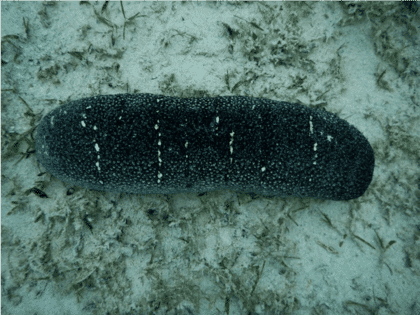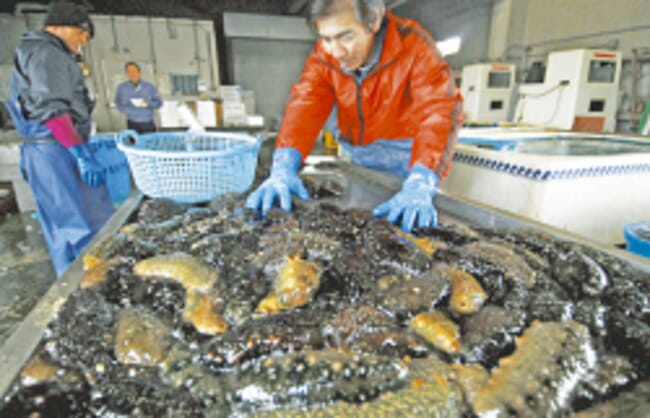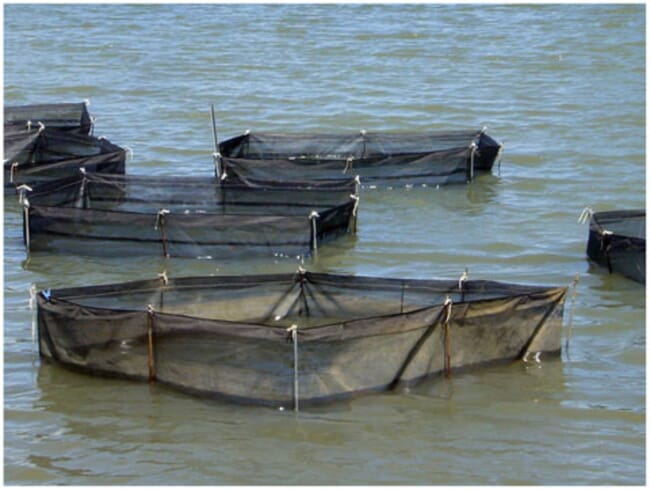A case study outlined in the International Journal of Fisheries and Aquatic Studies suggests that using mesh hapa nets when growing early-juvenile sea cucumbers could allow producers to successfully scale up production without incurring additional labour or water input costs.

The study, which was exploring the optimal stocking density of sea cucumbers (Holothuria scabra) in hapas*, noted that though the ideal stocking density in a hapa system was lower than in a commercial tank, the ease and efficiency of using the nets outweighed the benefits of tank production systems. It was more economical to use hapas to rear early-juvenile sea cucumbers. It was also easier to scale up production without courting environmental or welfare drawbacks with this method.
Why sea cucumbers?
Sea cucumbers have been collected and cultivated across Asia for centuries. Species like Holothuria scabra, or the sandfish, have been gathered from coastal regions of the Philippines since the 1700s. Recently, international demand for sandfish from the culinary and pharmaceutical sectors has given the species a high market value – and sea cucumber fisheries have expanded along with the market.
Though the expansion of the industry has contributed to the blue economy of many countries in the Asia-Pacific region, there is mounting evidence that natural stocks of sandfish have been overexploited, putting the entire industry in jeopardy. In light of this, many producers have transitioned to sustainable cultivation methods to meet the market demand for sea cucumbers while allowing natural stocks to rebound.

Though sandfish are well suited to sustainable aquaculture projects due to their effectiveness as biofilters, production is still labour intensive and difficult to scale up. This is especially true when producers are growing early-juveniles.
Typically, early-juveniles are grown in tanks with a stocking density of 500-700 individuals per m² until they reach stocking size for pond culture – usually between 1-20 grams. Space is the biggest constraint in sea cucumber hatcheries. Previous research has demonstrated that when juvenile sandfish are larger than 1 gram, they need more space and substrate to grow to maturity. This space pressure makes it difficult for producers to increase production outputs without courting disease or mortalities.
Where hapa nets come in
Researchers have been exploring the viability of hapa nets in sea cucumber aquaculture, believing that the mesh nets can allow producers to expand production in ocean nursery systems without increasing labour costs or water and aeration inputs. Other trials have shown that using hapas instead of tanks can significantly lower water costs, since the water exchange needs in hapa systems are nominal. This allowed farmers to use those resources to increase production numbers without harming the surrounding environment or the health of the sandfish. Though these trials demonstrated proof of concept, there is very little research on the optimal stocking density for early-juvenile sea cucumbers reared in hapas – making the widespread adoption of the method a difficult sell.
The trial and analysis
To determine the optimal stocking density for sandfish reared in hapa nets, the researchers tacked the growth and survival rate of early-juvenile sea cucumbers across three trials simultaneously. In the first trial, the researchers stocked acclimated sandfish in hapas at 250 individuals per m³ over a 42-day culture period. The second trial had a stocking density of 500 individuals per m³ and the third trial stocked the sandfish at 750 individuals per m³.
The researchers measured the weight and length of the sea cucumbers every two weeks to monitor the progression and survival of the stocks. They also tracked water parameters such as temperature, salinity, pH and dissolved oxygen. In order to gauge the environmental health of the production environment, the researchers collected and identified plankton species found in and around the hapa nets.

The results showed that sandfish reared at 250 individuals per m³ had the highest length and weight gains at the end of the 42-day culture period. This group also had the highest survivability rate of any of the groups – with 58.27 percent of individuals surviving the trial. The third experimental group (with the highest stocking density) showed the poorest performance results. This group had the lowest growth rate and the highest morality rate. Only 27.78 percent of individuals survived the 42-day culture period.
In the analysis, the researchers noted that all three experimental groups were exposed to the same environmental conditions. This means that issues of water quality or environmental variation didn’t impact the trial results – the growth performance and survival rate can be attributed to the stocking densities in the hapas.
The results suggest that lower stocking densities allow sea cucumbers to achieve higher growth and survivability. It also reduces instances of disease.
As part of their final conclusions, the researches conducted a cost-benefit analysis comparing tank culture methods with hapa nets. Though the optimal stocking density was lower in the hapas, the researchers felt that the extra maintenance required to keep tank conditions and water quality at healthy standards outweighed the potential biomass benefits. The production inputs to raise sandfish in tanks made it less economical.
Though these results are persuasive, there is one oversight in the case study. According to research published in the journal Aquaculture, sandfish need sandy mud or some other type of substrate to meet their nutritional needs and grow to maturity. The IJFAS study did not directly report whether there was any sand or substrate present in the hapas during the trial period.
However, based on the results of the three trials and the researchers’ previous experience, the hapas required minimal water management and no extra equipment expenditures to produce early-juvenile sea cucumbers. This makes the culture method an ideal way to sustainably scale up sandfish production.
*Hapas are square or rectangular mesh nets that can be placed in a pond or seawater to hold fish.
Read more about the trial in the International Journal of Fisheries and Aquatic Studies.




